Crank J. Free and Moving Boundary Problems
Подождите немного. Документ загружается.

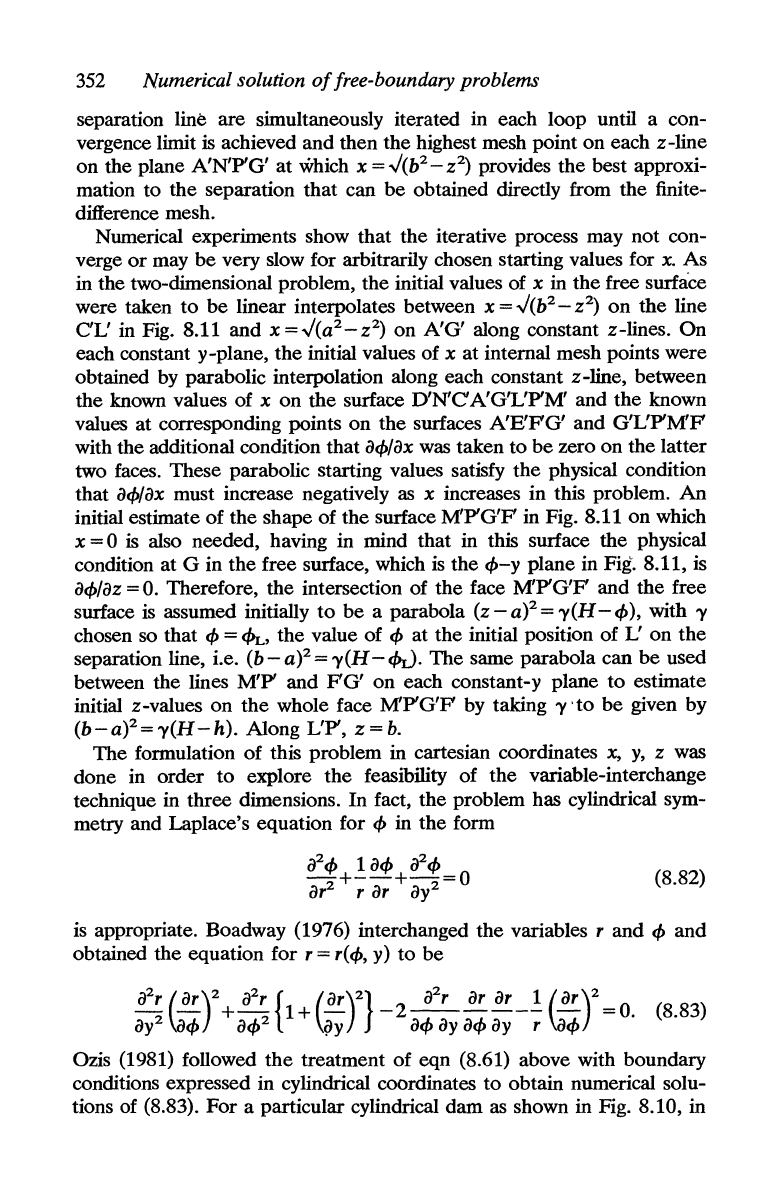
352
Numerical solution
of
free-boundary problems
separation line are simultaneously iterated in each loop until a con-
vergence limit is achieved and then the highest mesh point
on
each z-line
on
the plane
A'N'P'G'
at
which x = .J(b
2
-
Z2)
provides
the
best approxi-
mation
to
the
separation that can
be
obtained directly from the finite-
difference mesh.
Numerical experiments show
that
the
iterative process may
not
con-
verge
or
may
be
very slow for arbitrarily chosen starting values for
x.
As
in the two-dimensional problem,
the
initial values of x in
the
free surface
were taken
to
be
linear interpolates between x = .J(b
2
-
Z2)
on
the
line
CL'
in Fig. 8.11 and x = .J(a
2
-
Z2)
on
A'G'
along constant z-lines.
On
each constant y-plane,
the
initial values of x
at
internal mesh points were
obtained by parabolic interpolation along each constant z-line, between
the known values of
x
on
the
surface
D'N'CA'G'L'P'M'
and
the
known
values
at
corresponding points
on
the
surfaces
A'E'FG'
and
G'L'P'M'F
with the additional condition that
acf>/ax
was taken
to
be
zero
on
the
latter
two faces. These parabolic starting values satisfy
the
physical condition
that
acf>/ax
must increase negatively
as
x increases in this problem.
An
initial estimate of
the
shape
of
the surface
M'P'G'F
in Fig. 8.11
on
which
x = 0 is also needed, having in mind that in this surface
the
physical
condition
at
G in
the
free surface, which is
the
cf>-y
plane in Fig. 8.11, is
acf>/az
=
O.
Therefore,
the
intersection of
the
face
M'P'G'F
and
the
free
surface is assumed initially
to
be
a parabola (z -
a)2
=
y(H
-
cf»,
with y
chosen so that
cf>
=
<h,
the value of
cf>
at
the
initial position of L'
on
the
separation line, i.e.
(b-af=y(H-q,J.
The
same parabola can
be
used
between
the
lines M'P' and
FG'
on
each constant-y plane
to
estimate
initial z-values
on
the
whole face
M'P'G'F
by taking
y'to
be
given
by
(b-a)2=y(H-h).
Along L'P',
z=b.
The
formulation
of
this problem in cartesian coordinates
X,
y,
z was
done in order
to
explore
the
feasibility of
the
variable-interchange
technique in three dimensions.
In
fact,
the
problem has cylindrical sym-
metry and Laplace's equation for
cf>
in
the
form
a
2
cf>
1
acf>
a
2
cf>
-+--+-=0
ar2
r
ar
ay2
(8.82)
is appropriate. Boadway
(1976) interchanged
the
variables r and
cf>
and
obtained
the
equation for r = r(
cf>,
y)
to
be
a
2
r
(~)2
+ a
2
r {1+(ar)2}
-2~~
ar
_.!
(~)2
=0.
(8.83)
ay2
acf>
acf>2
!}y
acf>
ay
acf>
ay r
acf>
Ozis (1981) followed
the
treatment
of
eqn (8.61) above with boundary
conditions expressed in cylindrical coordinates
to
obtain numerical solu-
tions of
(8.83).
For
a particular cylindrical dam as shown in Fig. 8.10, in
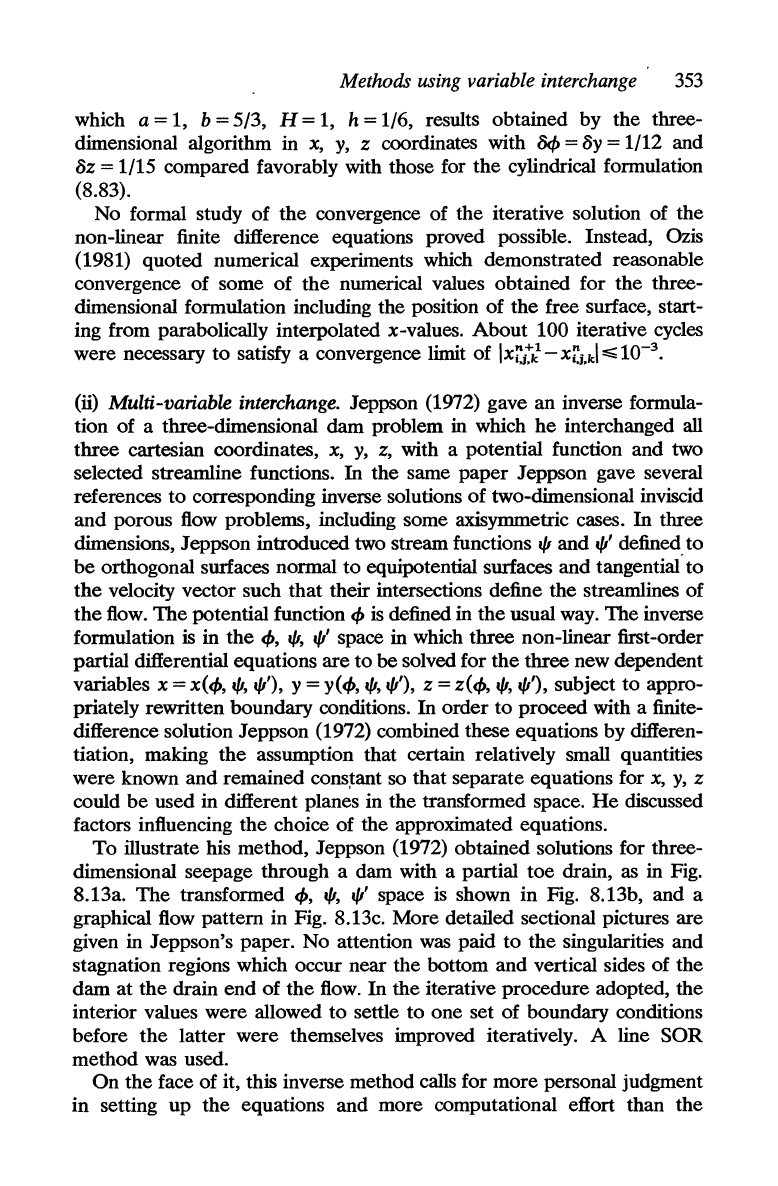
Methods using variable interchange
353
which a = 1, b = 5/3, H =
1,
h = 1/6, results obtained by the three-
dimensional algorithm in
x,
y,
z coordinates with
&f>
= 5y = 1/12 and
5z = 1/15 compared favorably with those for
the
cylindrical formulation
(8.83).
No formal study
of
the convergence of the iterative solution of the
non-linear finite difference equations proved possible. Instead, Ozis
(1981) quoted numerical experiments which demonstrated reasonable
convergence of some
of
the
numerical values obtained for the three-
dimensional formulation including the position of the free surface, start-
ing from parabolically interpolated x-values.
About
100 iterative cycles
were necessary
to
satisfy a convergence limit
of
Ix;:t,!-xu,kl.;;;10-
3
•
(ii) Multi-variable interchange. Jeppson (1972) gave an inverse formula-
tion
of
a three-dimensional dam problem in which
he
interchanged all
three
cartesian coordinates, x,
y,
z,
with a potential function and two
selected streamline functions.
In
the same paper Jeppson gave several
references to corresponding inverse solutions
of
two-dimensional inviscid
and porous flow problems, including some axisymmetric cases.
In
three
dimensions, Jeppson introduced two stream functions
1/1
and
1/1'
defined
to
be
orthogonal surfaces normal to equipotential surfaces and tangential'to
the
velocity vector such
that
their intersections define the streamlines of
the
flow.
The
potential function
</>
is
defined in
the
usual way.
The
inverse
formulation
is
in the
</>,
1/1,
1/1'
space in which three non-linear first-order
partial differential equations
are
to be solved for
the
three new dependent
variables
x =
x(</>,
1/1,
1/1'),
y =
y(</>,
1/1,
1/1'),
Z =
z(</>,
1/1,
1/1'),
subject to appro-
priately rewritten boundary conditions.
In
order
to
proceed with a finite-
difference solution Jeppson (1972) combined these equations by differen-
tiation, making the assumption that certain relatively small quantities
were known and remained
cons~ant
so
that
separate equations for
x,
y,
z
could
be
used in different planes in the transformed space.
He
discussed
factors influencing the choice of the approximated equations.
To
illustrate his method, Jeppson (1972) obtained solutions for three-
dimensional seepage through a dam with a partial toe drain, as in Fig.
8.13a.
The
transformed
</>,
1/1,
1/1'
space
is
shown
in
Fig. 8.13b, and a
graphical
flow
pattern in Fig. 8.13c. More detailed sectional pictures are
given in Jeppson's paper. No attention was paid
to
the singUlarities and
stagnation regions which occur near the bottom and vertical sides of the
dam
at
the
drain
end
of
the
flow.
In
the iterative procedure adopted, the
interior values were allowed
to
settle
to
one set
of
boundary conditions
before
the
latter were themselves improved iteratively. A line
SOR
method was used.
On
the face of it, this inverse method calls for more personal judgment
in
setting
up
the equations and more computational effort than the
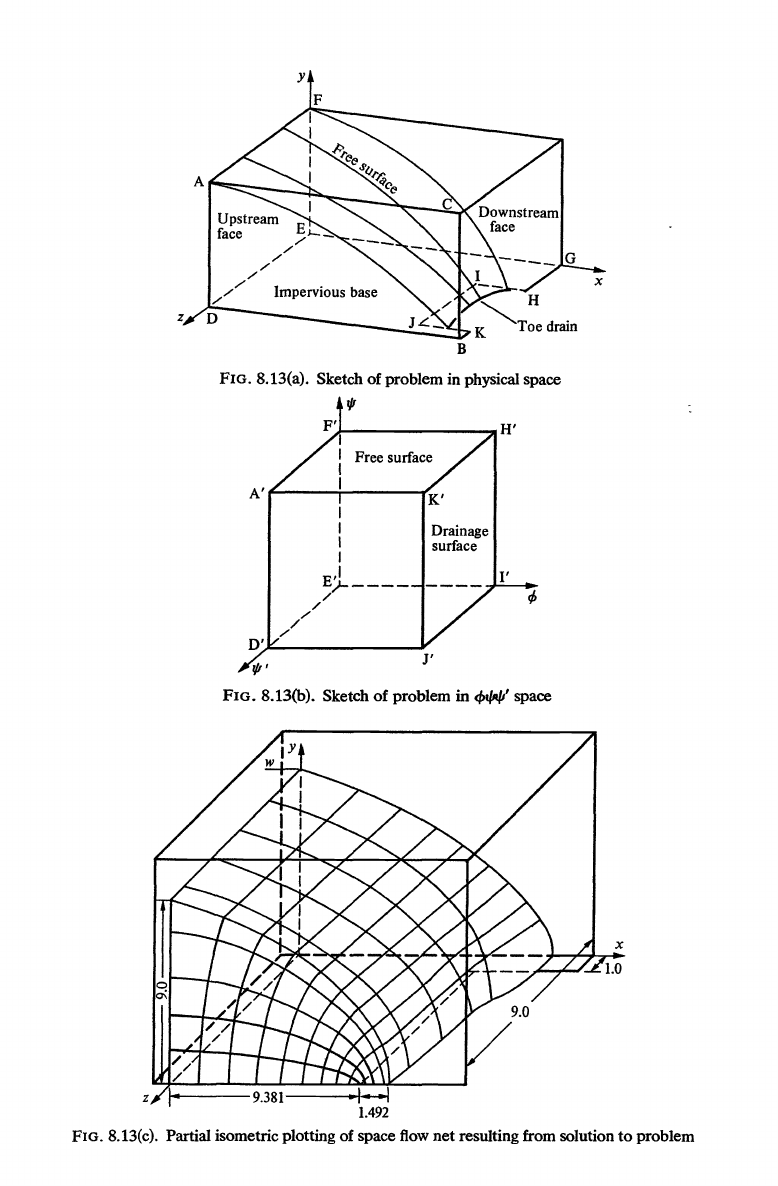
/
//
/
;>---
///
Impervious base
z D
B
FIG. 8.13(a). Sketch of problem in physical space
'"
A'~---:----~K'
///
I
I
I
I
E;L----
/
/
Drainage
surface
D'~'~
________
¥
rp'
J'
FIG. 8.13(b). Sketch
of
problem in
cf,t{It/J'
space
FIG.
8.
13(c). Partial isometric plotting
of
space
flow
net resulting from solution
to
problem
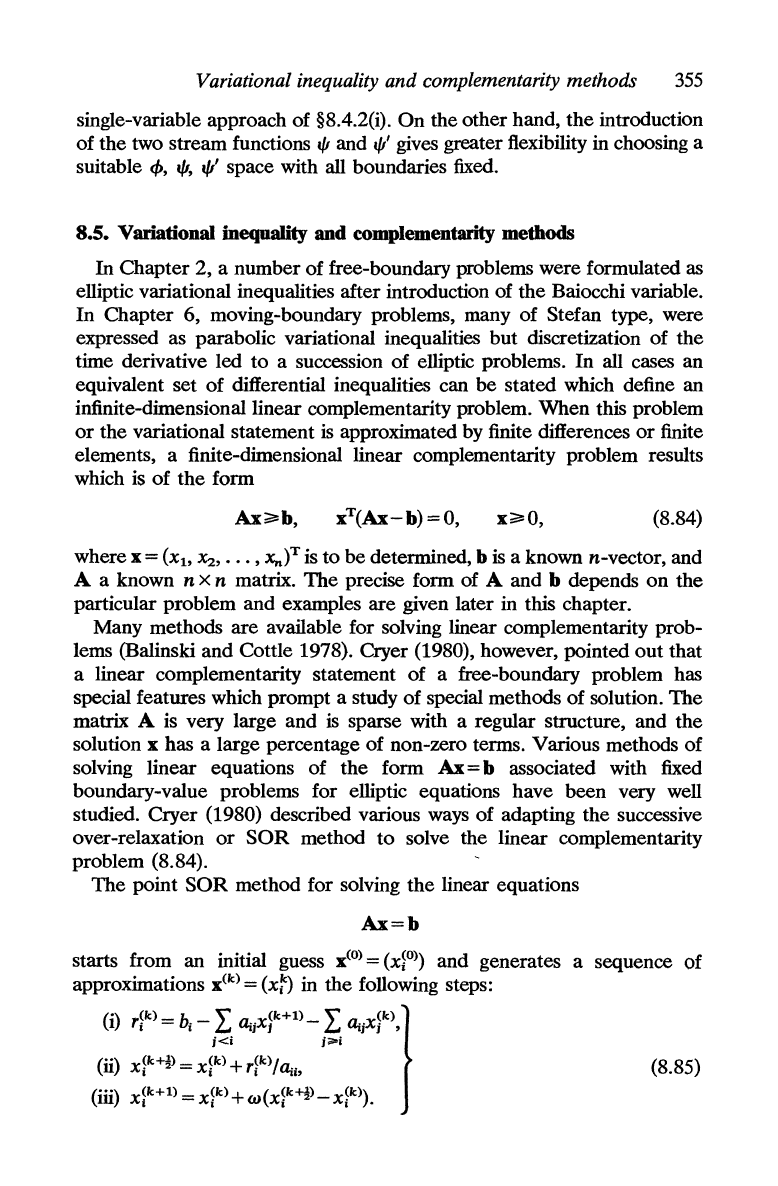
Variational inequality and complementarity methods
355
single-variable approach
of
§8.4.2(i).
On
the
other
hand,
the
introduction
of
the
two
stream
functions
t/I
and
t/I'
gives greater flexibility in choosing a
suitable
lb,
t/I,
t/I'
space with all boundaries fixed.
8.S. Variational ineqnality and complementarity methods
In
Chapter
2, a
number
of
free-boundary problems were formulated as
elliptic variational inequalities after introduction of
the
Baiocchi variable.
In
Chapter
6, moving-boundary problems, many
of
Stefan type, were
expressed as parabolic variational inequalities
but
discretization
of
the
time derivative
led
to
a succession
of
elliptic problems.
In
all cases
an
equivalent
set
of
differential inequalities can
be
stated
which define an
infinite-dimensional linear complementarity problem.
When
this problem
or
the variational statement
is
approximated by finite differences
or
finite
elements, a finite-dimensional linear complementarity problem results
which is
of
the
form
Ax;;;;:b,
(8.84)
where
x =
(Xl>
~,
•••
, x,.)T is
to
be
determined, b is a known n-vector, and
A a known n x n matrix.
The
precise form of A and b depends
on
the
particular
problem
and
examples
are
given later in this chapter.
Many methods
are
available for solving linear complementarity prob-
lems (Balinski
and
Cottle 1978). Cryer (1980), however, pointed
out
that
a linear complementarity statement
of
a free-boundary problem has
special features which
prompt
a study
of
special methods
of
solution.
The
matrix A is very large
and
is
sparse with a regular structure, and
the
solution x has a large percentage
of
non-zero terms. Various methods
of
solving linear equations
of
the
form
Ax
= b associated with fixed
boundary-value problems for elliptic equations
have
been
very well
studied.
Cryer
(1980) described various ways
of
adapting
the
successive
over-relaxation
or
SOR
method
to
solve the linear complementarity
problem (8.84).
The
point
SOR
method
for solving
the
linear equations
Ax=b
starts from an initial guess
x(O)
=
(x~O)
and
generates a sequence
of
approximations
X(k)
=
(xf)
in
the
following steps:
(i)
r~k)
= b
i
-
L tl;jX}k+1) - L tl;jX}k)
'}
j<i
j;a.i
(ii)
X~k+!)
=
Xfk)
+
r~k)
I tl;b
(iii)
Xfk+l)
=
X~k)
+
w(X~k+!)-
Xfk).
(8.85)
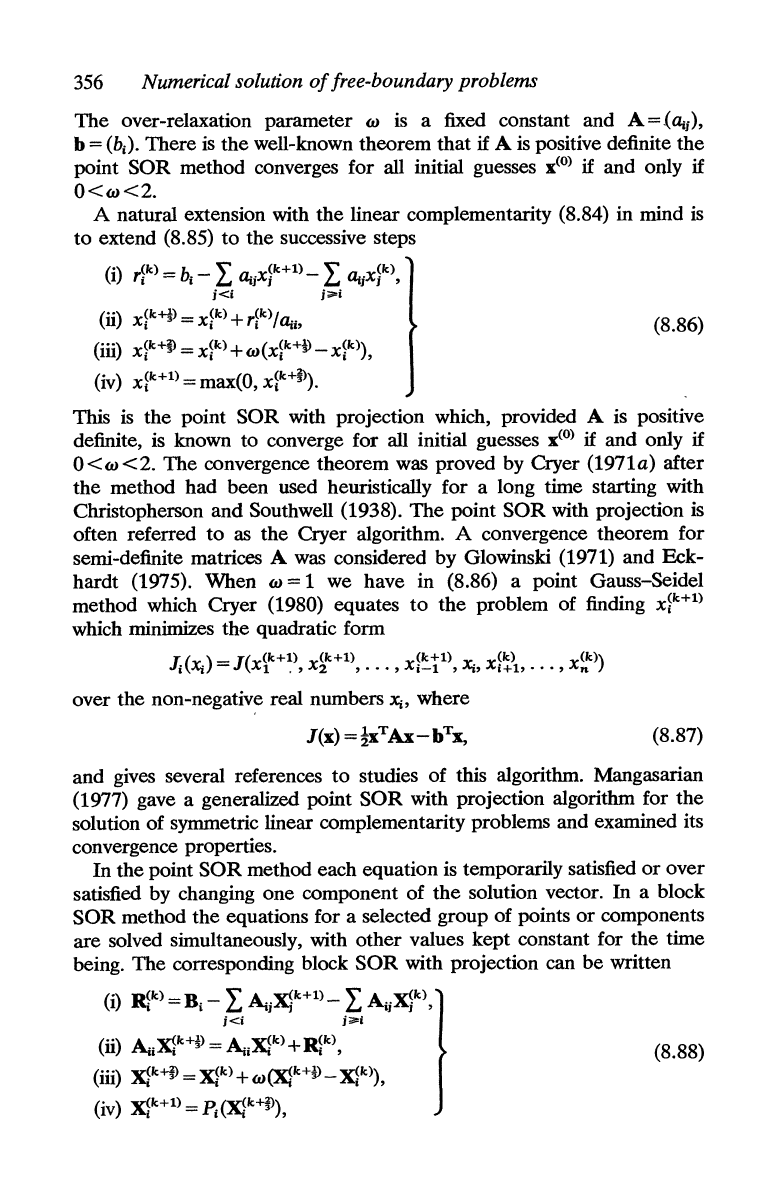
356
Numerical solution
of
free-boundary problems
The
over-relaxation parameter w
is
a fixed constant and
A=.(tl;j),
b =
(b
i
).
There
is
the well-known theorem that
if
A
is
positive definite the
point
SOR
method converges for all initial guesses
x(O)
if
and only
if
0<w<2.
A natural extension with the linear complementarity (8.84) in mind
is
to
extend (8.85) to the successive steps
(
i)
lk)
=
b.
-
""
n
..
x~k+l)
-
""
n··x~k)
1
'i.J-tJ
J
/""-'1
J ,
j<i
j;;=i
(ii) X[k+1) =
X~k)
+
r[k)
/
tl;b
(iii)
X~k+~
=
X~k)
+
W(X[k+i>
-
X[k»,
(iv)
X~k+l)
=
max(O,
x[k+~».
(8.86)
This
is
the point
SOR
with projection which, provided A is positive
definite, is known to converge for all initial guesses
x(O)
if
and only
if
0<w<2.
The
convergence theorem was proved by Cryer (1971a) after
the method had been used heuristically for a long time starting with
Christopherson and Southwell
(1938).
The
point
SOR
with projection
is
often referred to as the Cryer algorithm. A convergence theorem for
semi-definite matrices A was considered by Glowinski
(1971) and
Eck-
hardt (1975). When w = 1 we have in (8.86) a point Gauss-Seidel
method which Cryer
(1980) equates
to
the problem of finding X[k+1)
which minimizes the quadratic form
!;(X;)
=J(X~k+~),
X~k+1),
•••
,
x~~tl),
x;,
x~~t
•••
,
x~»
over the non-negative real numbers X;, where
J(x)=!xTAx-bTx,
(8.87)
and gives several references
to
studies of this algorithm. Mangasarian
(1977) gave a generalized point
SOR
with projection algorithm for the
solution of symmetric linear complementarity problems and examined its
convergence properties.
In
the point
SOR
method each equation is temporarily satisfied
or
over
satisfied by changing one component
of
the solution vector.
In
a block
SOR
method the equations for a selected group of points
or
components
are solved simultaneously, with other values kept constant for the time
being. The corresponding block
SOR
with projection can
be
written
(i)
~k)
= Bi - L
~j~k+1)
- L
Aij~k),
j<i
j;oi
(ii)
~iK;k+i)
=
~iK;k)
+
~k),
(iii)
K;k~
=
X~k)
+ w(K;k+l) - K;k»,
(iv)
xf
k
+1)
=
Pi(K;k~»,
(8.88)
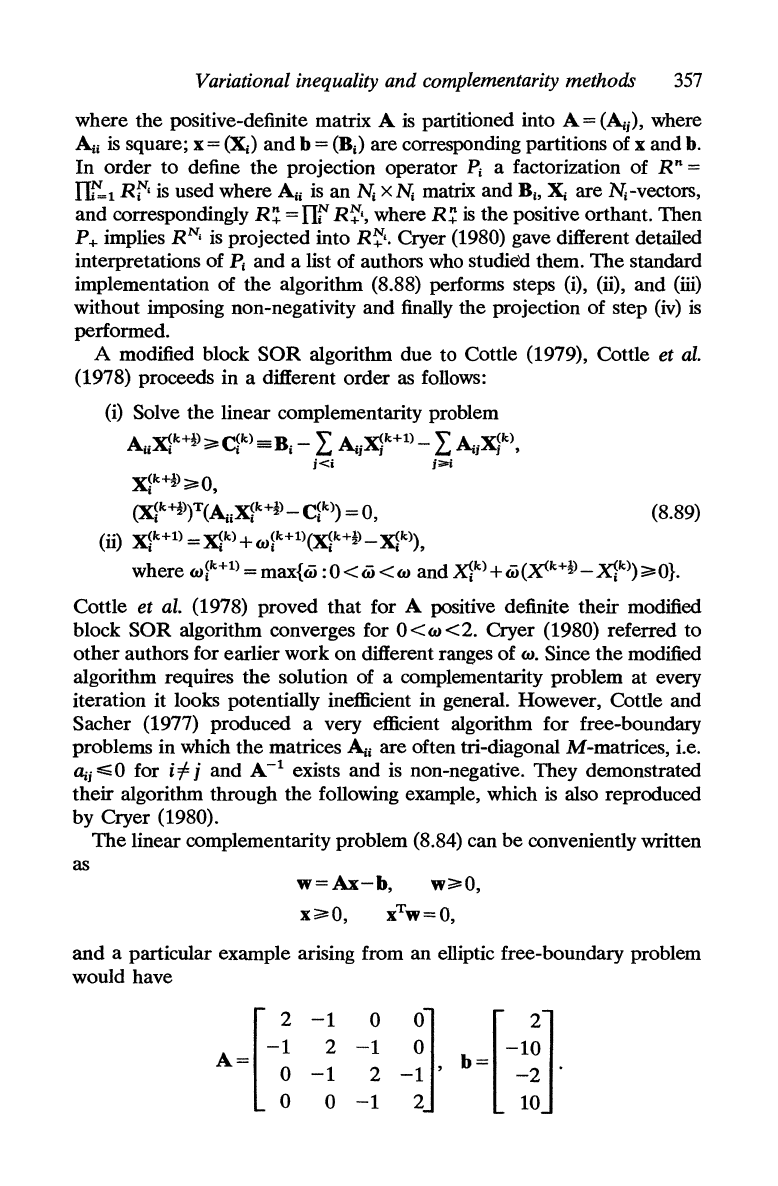
Variational inequality and complementarity methods
357
where the positive-definite matrix A
is
partitioned into A =
(~j),
where
Au
is
square; x = (X;)
and
b = (BI) are corresponding partitions of x and b.
In
order
to
define
the
projection operator
PI
a factorization of
R"
=
~l
Ri"
is
used where Au is an
N;
xN;
matrix and
Bi>
X; are N;-vectors,
and correspondingly
R~
= IIi'
R~',
where
R~
is the positive orthant. Then
P
+ implies R
N
,
is projected into
R~·.
Cryer (1980) gave different detailed
interpretations of
Pi
and a list of authors who studied them.
The
standard
implementation of
the
algorithm (8.88) performs steps (i), (ii), and (iii)
without imposing non-negativity and finally the projection of step
(iv)
is
performed.
A modified block
SOR
algorithm due to Cottle (1979), Cottle et
al.
(1978) proceeds in a different order
as
follows:
(i)
Solve the linear complementarity problem
A
.~k+fl:;;;.C"~k)=B._
~
A
..
~k+l)_
~
A ..
~k)
.t"1i,Ai
'-'i
'~'J
J
~
ESiJ J ,
j<1
i""l
x~k+fl
:;;;.0,
(X~k+!))T(~I~k+!)
- elk)) = 0,
(8.89)
(ii)
~k+l)
=
~k)
+
Wlk+l)(~k+~
_
~k)),
where
wl
k
+1)
=max{w
:O<w
<wand
Xi
k
)+
w(X<k+!)-
~k)):;;;.O}.
Cottle et
al.
(1978) proved
that
for A positive definite their modified
block
SOR
algorithm converges for
0<w<2.
Cryer (1980) referred
to
other
authors for earlier work on different ranges
of
w.
Since
the
modified
algorithm requires
the
solution of a complementarity problem at every
iteration it looks potentially inefficient in general. However, Cottle and
Sacher (1977) produced a very efficient algorithm for free-boundary
problems in which
the
matrices
~i
are often tri-diagonal M-matrices, i.e.
(l;j:S;;O for
i=!=
j and
A-I
exists and is non-negative. They demonstrated
their
algorithm through the following example, which
is
also reproduced
by Cryer (1980).
The
linear complementarity problem (8.84) can
be
conveniently written
as
w=Ax-b,
w*,O,
and
a particular example arising from an elliptic free-boundary problem
would have
[
-~
A=
o
o
-~
-~
~]
=[-1~]
-1
2
-1
,b
-2·
o
-1
2 10
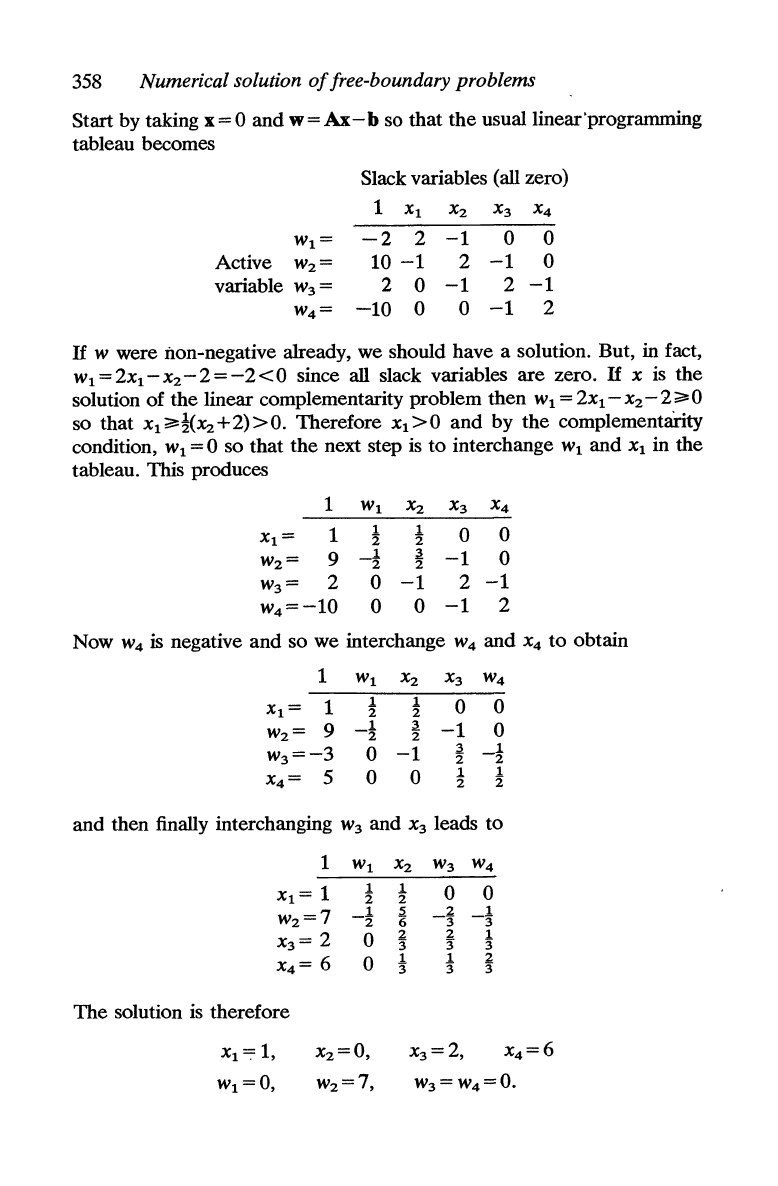
358
Numerical solution
of
free-boundary problems
Start by taking
x=O
and
w=Ax-b
so that
the
usuallinear'progranuning
tableau becomes
Slack variables (all zero)
1
Xl
X2
X3 X4
W
l
=
-2
2
-1
0 0
Active
W2=
10
-1
2
-1
0
variable
W3
=
2
0
-1
2
-1
W4=
-10
0 0
-1
2
If
W were non-negative already, we should have a solution. But, in fact,
WI=2xl-X2-2=-2<0
since all slack variables are zero.
If
X
is
the
solution
of
the linear complementarity problem then
WI
=
2Xl
- X2 -
2;;l!:
0
so that XI;;l!:!(Xz+2»0. Therefore
XI>O
and
by the complementanty
condition,
WI
= 0 so
that
the next step
is
to
interchange
WI
and
Xl
in the
tableau. This produces
1
WI
X2
X3
X4
Xl=
1
1 1
0
0
2
2
W2=
9
-!
~
-1
0
2
W3=
2 0
-1
2
-1
w4=-10
0 0
-1
2
Now
W4
is negative and so we interchange
W4
and X4
to
obtain
1
WI
X2 X3
W4
Xl
= 1
1 1
0 0
2 2
W2=
9
I
~
-1
0
-2
2
W3=-3
0
-1
~
-!
2
X4=
5 0 0
~
1
2 2
and then finally interchanging
W3
and X3 leads
to
1
WI
X2
W3
W4
Xl
= 1
1 1
0 0
2
2
W2=7
-!
2
2
-t
6
-3"
X3=
2 0
~
2
1
3
3"
3
X4=
6 0
1
1
~
3 3 3
The
solution
is
therefore
X3=2,
x4=6
W3=W4=0.
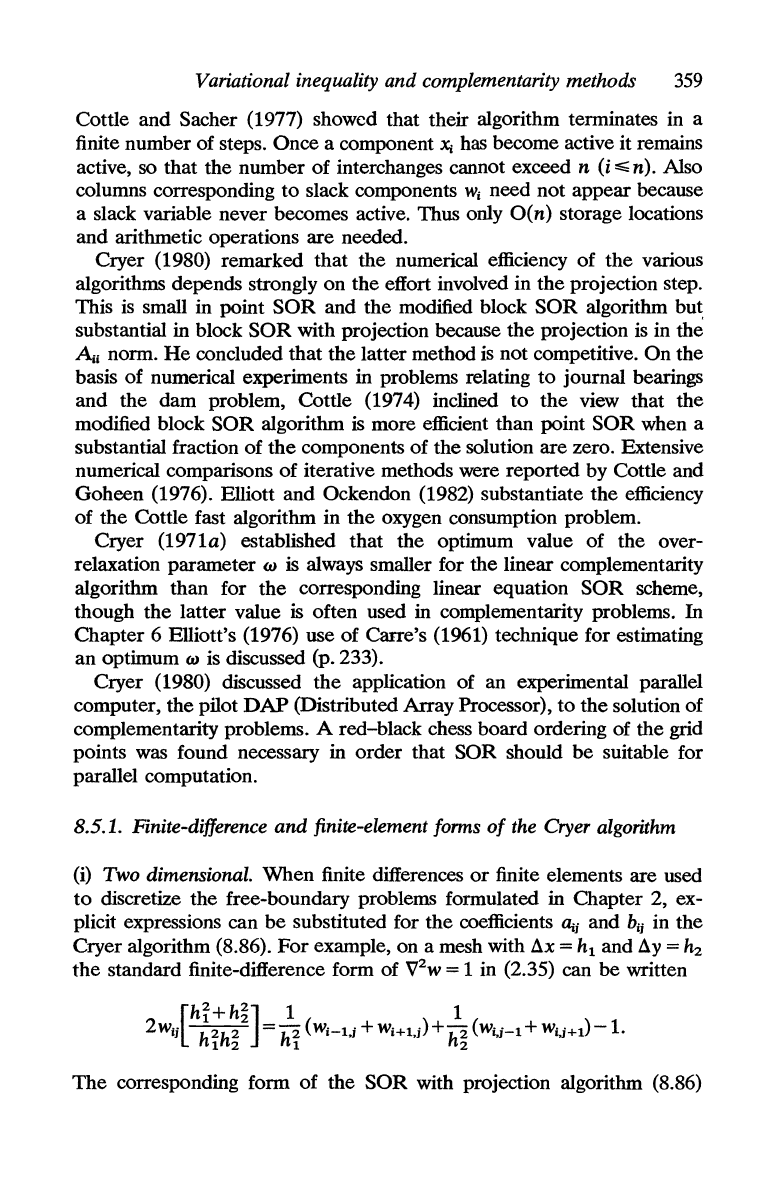
Variational inequality and complementarity methods
359
Cottle and Sacher (1977) showed that their algorithm terminates in a
finite number of steps. Once a component
Xj has become active
it
remains
active, so that the number
of
interchanges cannot exceed n
(i:s;;;
n). Also
columns corresponding to slack components
Wi
need not appear because
a slack variable never becomes active. Thus only
O(n)
storage locations
and arithmetic operations are needed.
Cryer (1980) remarked
that
the numerical efficiency
of
the
various
algorithms depends strongly on the effort involved in the projection step.
This
is
small in point
SOR
and the modified block
SOR
algorithm but
substantial in block
SOR
with projection because the projection
is
in the
A;i
norm.
He
concluded that the latter method
is
not competitive. On the
basis of numerical experiments in problems relating
to
journal bearings
and the dam problem, Cottle (1974) inclined to
the
view that the
modified block
SOR
algorithm
is
more efficient than point
SOR
when a
substantial fraction
of
the
components
of
the solution are zero. Extensive
numerical comparisons
of
iterative methods were reported by Cottle and
Goheen (1976). Elliott and Ockendon (1982) substantiate the efficiency
of
the Cottle fast algorithm in
the
oxygen consumption problem.
Cryer
(1971a) established
that
the optimum value
of
the over-
relaxation parameter
w is always smaller for the linear complementarity
algorithm than for the corresponding linear equation
SOR
scheme,
though the latter value
is often used in complementarity problems.
In
Chapter 6 Elliott's (1976) use of Carre's (1961) technique for estimating
an
optimum w is discussed (p.233).
Cryer (1980) discussed the application of an experimental parallel
computer, the pilot
DAP
(Distributed Array Processor),
to
the solution of
complementarity problems. A red-black chess board ordering of the grid
points was found necessary in order that
SOR
should
be
suitable for
parallel computation.
8.5.1. Finite-difference and finite-element forms
of
the Cryer algorithm
(i)
Two dimensional. When finite differences
or
finite elements are used
to
discretize the free-boundary problems formulated in Chapter 2, ex-
plicit expressions can
be
substituted for the coefficients ll;j and b
ij
in the
Cryer algorithm (8.86).
For
example, on a mesh with
Ax
= hl and
Ay
=
h2
the
standard finite-difference form of V
2
w = 1 in (2.35) can
be
written
The
corresponding form
of
the
SOR
with projection algorithm (8.86)
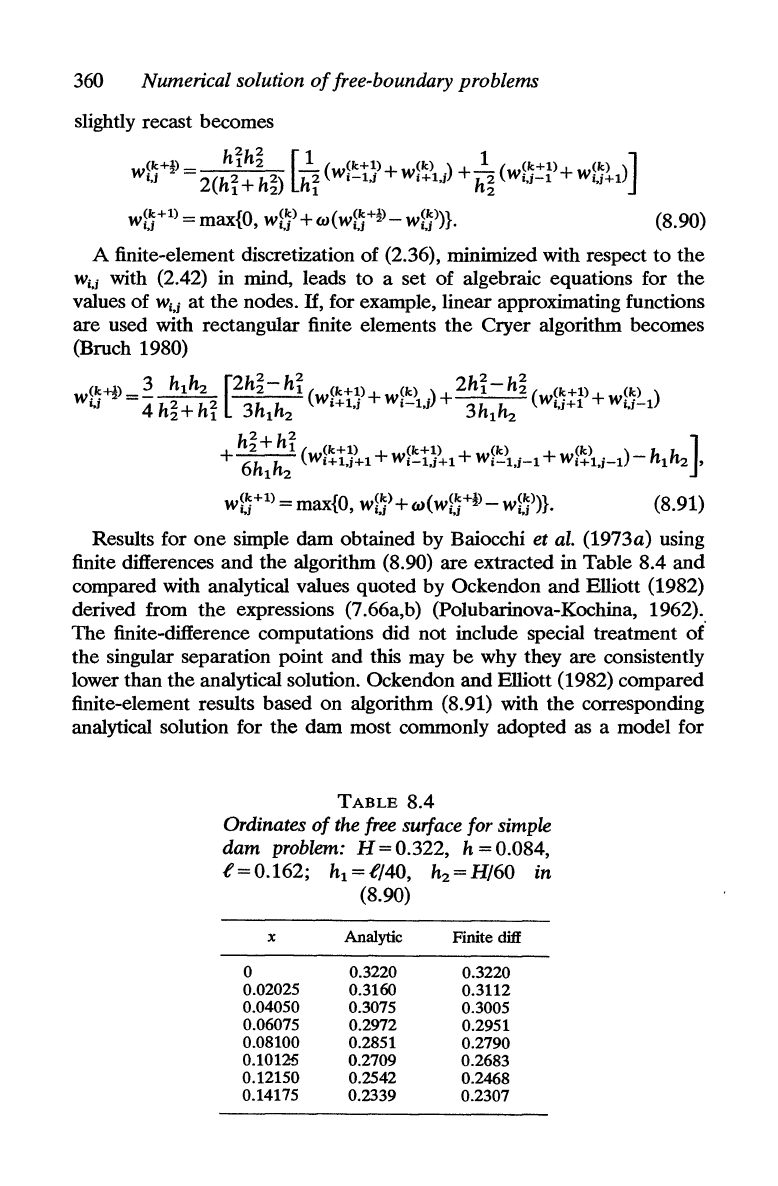
360
Numerical solution
of
free~boundary
problems
slightly recast becomes
(k+:P
_
hih~
[-.!..
«k+l)
(k)
-.!..
«k+1)
(k)]
Wi,i
-
2(hi+
h~)
hi
Wi-IJ +
Wi+1,i
+
h~
Wi,i-l
+
Wi,i+1)
Wl~+l)
=
max{O,
wl~)+w(w!1+!)-wl~)}.
(8.90)
A finite-element discretization
of
(2.36), minimized with respect to
the
Wi,i
with (2.42) in mind, leads to a set
of
algebraic equations for the
values
of
wi,i
at
the
nodes.
H,
for example, linear approximating functions
are used with rectangular finite elements the Cryer algorithm becomes
(Bruch 1980)
(k+!)_~
hlhz
[2h~-hi(
(k+l)
(k)
2hi-h~
(k+l)
(k)
WiJ
2 - 4
h~+
hi
3h
1
h
2
Wi+1,i
+Wi-l,i +
3h
1
h
2
(wi,i+l +Wi,i-l)
h~+hi(
(k+l)
(k+1)
(k)
(k)
)-h
h ]
+ 6h
1
h
2
Wi+1,i+l
+ Wi-1J+l + Wi-l,i-l +
Wi+1,i-1
I 2 ,
w!~+1)
=
max{O
W!~)
+
w(w!~+!)
-
w!~)}
(8.91)
l~J
'I,J
I,J
1,1·
Results for
one
simple dam obtained by Baiocchi et
al.
(1973a) using
finite differences and the algorithm (8.90) are extracted in Table 8.4
and
compared with analytical values quoted by Ockendon and Elliott (1982)
derived from the expressions (7.66a,b) (Polubarinova-Kochina, 1962).
The
finite-difference computations did not include special treatment
of
the singular separation point and this may
be
why they are consistently
lower than the analytical solution. Ockendon and Elliott (1982) compared
finite-element results based on algorithm (8.91) with
the
corresponding
analytical solution for the dam most commonly adopted as a model for
TABLE
8.4
Ordinates
of
the
free
surface for simple
dam problem:
H = 0.322, h = 0.084,
f=0.162;
hI
=f/40,
h2
=H/60
in
(8.90)
x Analytic
Finite
di1f
0 0.3220
0.3220
0.02025
0.3160 0.3112
0.04050
0.3075
0.3005
0.06075
0.2972
0.2951
0.08100
0.2851 0.2790
0.1012!i
0.2709
0.2683
0.12150
0.2542
0.2468
0.14175
0.2339
0.2307
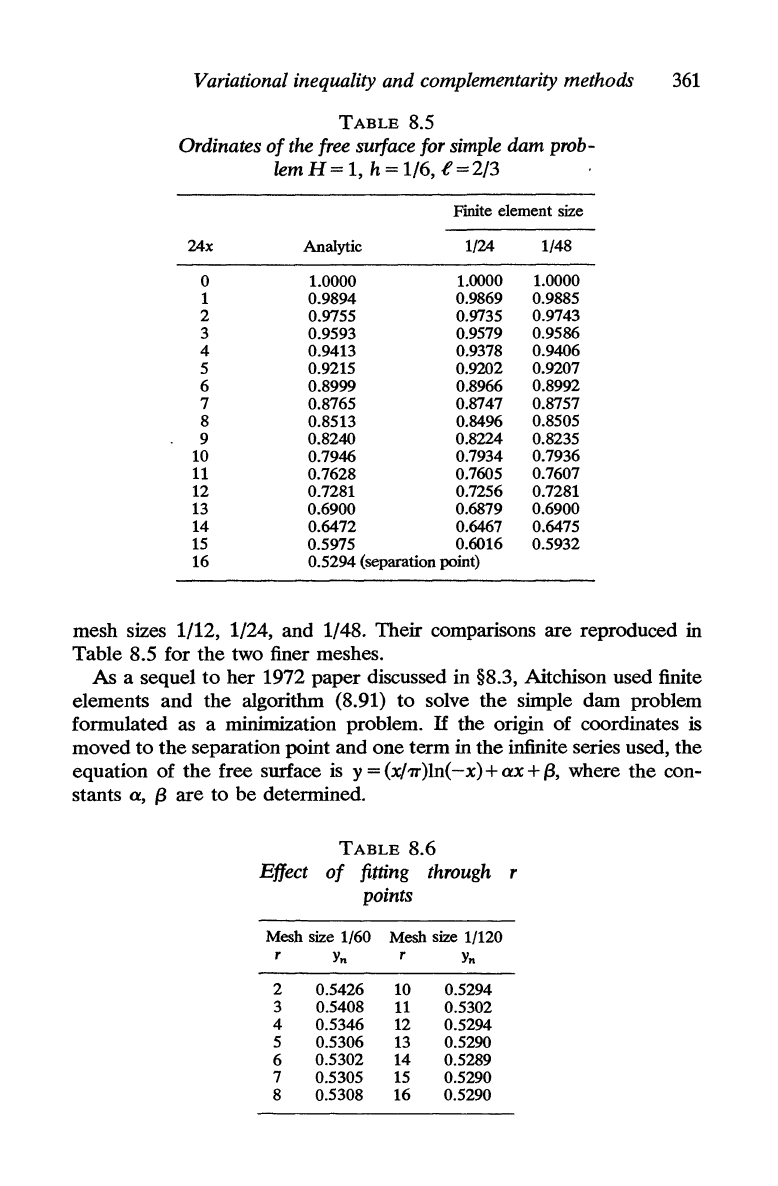
Variational inequality and complementarity methods
361
TABLE
8.S
Ordinates
of
the free surface for simple dam prob-
lem H = 1, h = 1/6, t
==
2/3
Finite element size
24x Analytic
1/24 1/48
0
1.0000
1.0000 1.0000
1
0.9894
0.9869 0.9885
2
0.9755 0.9735
0.9743
3
0.9593
0.9579 0.9586
4
0.9413 0.9378
0.9406
5 0.9215 0.9202 0.9207
6 0.8999 0.8966
0.8992
7
0.8765
0.8747 0.8757
8
0.8513 0.8496
0.8505
9 0.8240 0.8224 0.8235
10
0.7946
0.7934
0.7936
11
0.7628
0.7605 0.7607
12 0.7281 0.7256 0.7281
13 0.6900 0.6879
0.6900
14
0.6472 0.6467 0.6475
15
0.5975
0.6016 0.5932
16
0.5294 (separation point)
mesh sizes 1/12, 1/24,
and
1/48.
Their
comparisons
are
reproduced in
Table
8.S for
the
two finer meshes.
As
a sequel
to
her
1972
paper
discussed in §8.3, Aitchison used finite
elements
and
the
algorithm (8.91)
to
solve
the
simple
dam
problem
formulated as a minimization problem. H the origin
of
coordinates is
moved
to
the
separation point
and
one
term
in
the
infinite series used,
the
equation
of
the
free surface is y = (xhr )In(
-x)
+
ax
+
{3,
where
the
con-
stants a,
{3
are
to
be
determined.
TABLE
8.6
Effect
of
fitting
through
r
points
Mesh size 1/60 Mesh size 1/120
r
Y
n
r
Y
n
2
0.5426 10 0.5294
3 0.5408
11
0.5302
4
0.5346 12 0.5294
5
0.5306 13 0.5290
6
0.5302
14
0.5289
7
0.5305
15
0.5290
8 0.5308 16 0.5290
